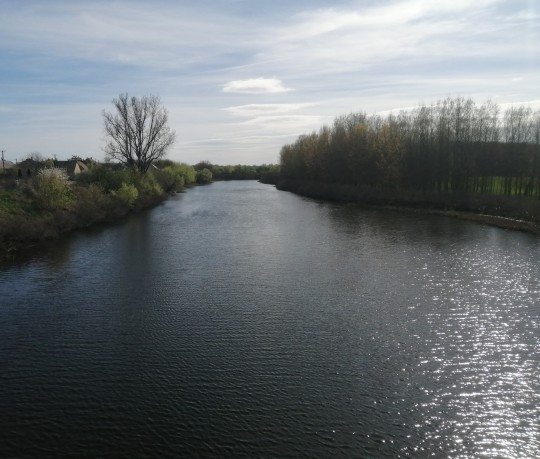#Tisza River
Text

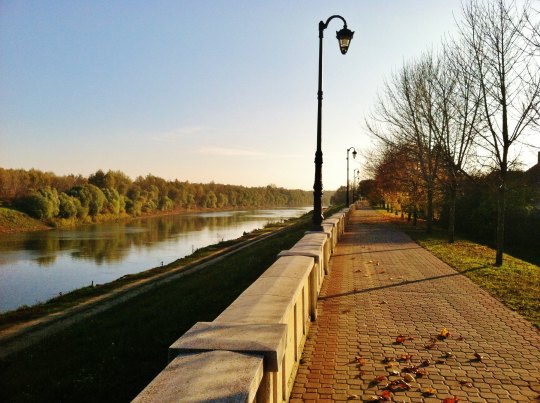


Szolnok, Hungary - 2015/2016. (2) (3) (4) by Kenneth Seech
Via Flickr:
Along the Tisza River.
7 notes
·
View notes
Text
Satellite imagery has revealed a network of more than 100 Bronze Age structures hidden in the Serbian plains.
Archaeologists first noticed the remnants of the more than 3,000-year-old enclosures in 2015 while reviewing Google Earth photos of a 93-mile stretch (150 kilometer) of wilderness along Serbia's Tisza River, according to a study published Nov. 10 in the journal PLOS One.
"We could see traces of over 100 Late Bronze Age settlements," study lead author Barry Molloy, an associate professor of archaeology at University College Dublin, told Live Science in an email. "What is fascinating about the [sites] is that we not only identified their presence in these images, but also measured their size and, for many, how people organized the layout inside their settlements."
He added, "It is quite unique in European Bronze Age archaeology to get this level of detail for so many settlements in such a specific area."
Previously, this area, known as the Pannonian Plain, was thought to be a hinterland not used for Bronze Age settlements. But now, researchers think that this is just one example of the many settlements found across Europe that are part of an extensive trade network from the time.
Continue Reading.
47 notes
·
View notes
Note
1, 18 and 28!!! Also I want to say that lake Balaton is one of the most beautiful places I have ever seen 😍
A fun fact about Lake Balaton is that there is a... lets say, mockup conspiracy group, modelled after the flat earth believers, who (ironically) think that Lake Balaton does not exist... Which is sometimes actually true, when the weather is too hot that the water just evaporates and the lake shrinks so much in size that it can be barely considered a lake anymore.
1. favourite place in your country?
I gotta say Budapest, which is the capital city, where I live. I'm originally from the norther-eastern side of Hungary, we moved to Budapest in '99, and while I like that part of the country still, I cannot imagine ever living anywhere else than Budapest in Hungary. The whole infrastucture of the country is set up in a way that the capital is The Center, so everything is here. I like the busy city life, so it's really my jam.
18. do you speak with a dialect of your native language?
Probably? It depends on who you ask. When I was a kid my Eastern Hungarian "accent" was very thick (which I think was probably hilarious because I looked extremely Asian as a kid, yet I spoke like a constantly drunk middle-aged Hungarian factory worker). I've been living in Budapest for 25 years, so this dialect disappeared from my speech, only some phrases and specific wording stayed that usually slip into my sentences accidentally. (My bf lived in the capital all his life, so he often points out and even makes fun of my "countryside dialect".)
28. does your country have a lot of lakes, mountains, rivers? do you have favourites?
We have some lakes, the biggest one is Lake Balaton. The two biggest rivers are the Danube and Tisza. Generally speaking, we have a lot of water in Hungary (except a sea, lol), so thermal baths are all over the country, in the most noname little villages even. About mountains, well. We like to call them mountains, but they barely register as a hill, I mean our highest is a few metres over 1000m? Hungary is mostly very flat, you can see far-far away and see nothing really, which can be a mood, I'm not gonna lie. The most famous poet Sándor Petőfi was really into the flatness of Hungary, he wrote multiple poems about what a liberating feeling it is for him to just see the flat earth for miles and miles, without anything else to "cage" it. (I don't like his poetry that much tbh.) I'm a city girl, so I'm not really moved by nature in general, but I like the area where I was born, which is where our "mountains" are. It's not a very popular area, because that county is one of the poorest and populated by the least educated people. We have a lot of castles and wine there tho! (Ironically, I prefer wines from Lake Balaton over wines from Eger.🙈)
13 notes
·
View notes
Text
i think being a chess enjoyer prepared me for this well. nothing's real nothing stays the same only the barest bones of the story there's only the chess match and the russian and the american and florence the madman and the blue box and the companion. everything else is subject to change. i think it's rlly interesting on principle like yknow how a fairytale has a million versions all slightly different and well that's not how MY mother told me when i was six years old the dragon had three heads and not seven the river in that song about swings is duna not tisza the madman in the box has a rainbow coat not a leather one he was born he was loomed he's half stupid on his mother's side. florence's father is alive he's dead he's a spy the american wins the russian wins out of spite he has two children he has no children clara oswald died in victorian times she was killed by a bird she was a dalek walter's last name is de courcey sam jones has dark hair walter's last name is anderson sam jones is blonde and has never smoked in her life. can anyone hear me
11 notes
·
View notes
Text

Little filler information/trivia post which didn't make it into the verse post because it was already long.
🇭🇺 Rozália is half Italian in this verse (instead of quarter like in the main one)
🩸 She is fluent in Italian, Turkish, Arabic (can read & write as well) and can understand, read in Latin. She secretly enjoys reading Arabic poetry.
🇭🇺 She is not religious and doesn't see this war, occupation as Christianity against Islam. Both her mother and father were Christians, look where their belief had gotten them. God won't do shit, she's wielding the blade, she's studying warfare to save people. She won't interfere with anyone's faith, not say anything unprompted, but if asked she will tell her opinion.
🩸 After acquiring language skills along with physical ones, she only saw Attila as hindrance. His decisions were either rash or too drawn out, he kept paying the lazy, unfaithful mercenaries, sat so high on his horse with nothing to show for such arrogance.
🇭🇺 Her father would've survived the infection as his fever was receding. Rozália was by his side, duty of the daughter masking her hope of finally being free from him. A small, quiet argument broke out after the mention of Lorella, how Attila should've died instead of her. He replied if God didn't want her to live, it wasn't his place to overrule. Rozália argued it would've been his duty to protect his wife and mother of his child. Attila said maybe she would be still alive if she had a son instead. Rozália snapped and choked her father to death in a silent, bottled up, bestial rage. No one questioned how the Count died, everyone assumed the infection had taken him. She never corrected them.
🩸 With her father out of the way, she easily could push through her reforms, her daring but well supported and rewarding tactics; earning both the soldiers' and the people's respect. After Főnixvár had been built, stronger than ever, she was presented with a pendant of iron: a sharp gothic cross with a dragon wrapped around it. Within the jewelry sat the last four rubies she paid lower ranked nobility for workers. Deeply touched by the gesture and the symbolism, it is a permanent addition of her everyday wardrobe.
🇭🇺 The Tisza river acts like a natural border, making the southern walls impossible to attack with artillery. The current is strong, prone to floods due to the curve, making across it even on foot is dangerous. It also means a permanent clean water supply, poison would be carried away by the current. The usually flooded areas create natural swampy ground, larger troop movements, machines are slow in the sticky mud and usually get stuck. Because of the closeness of the river, digging trenches under the reinforced stone base is fruitless, only getting a splash of muddy groundwater.
🩸 During the rebuilding stage was when Rozália found Vihar and bonded with the horse. The two are inseparable and she cannot imagine riding an another horse. She is a skilled esquetarian, able to ride without saddle, has a frighteningly accurate aim with a bow from horseback.
🇭🇺 Her and Selim Pasha sometimes run into each other during their own border patrol. The encounters are strangely civil, a brief stop in time itself. They had come to terms one of them won't make it alive and it was the Pasha who made it clear first, if she falls, she will be buried with utmost respect. Rozália swore the same to him. Their small talk sometimes in Turkish, sometimes in Hungarian, are about trivial, everyday things with an occasional compliment of the other's skill.
🩸 When she was a child, rebellious and a little hotheaded she sometimes snuck away into the forest. She often met a Turkish boy, Demir a few years older and she came home bloodied from the fights. None of them truly comprehended the reality of the situation. Despite now commander of a janissary unit, the tables have turned: the wild Hungarian child from the forest became a warlord.
🇭🇺 This woman has never worn skirts in her life. Sometimes her cape is draped around her shoulders, the outside bright crimson, but inside are the colors of the Hungarian flag itself. Rozália knows she will perish and makes most of her talents to become a legend, a hero to the point where her torture and execution wouldn't break the fighting spirit but strengthen it. She doesn't marry, she doesn't have time for that, all good men are either dead or already taken. She has no interest in a mewling coward of a noble. She is riddled with scars from victorious fights, always in the frontline of defense and offense.
🩸 Approximately there are 2500-3000 professional soldiers protecting the fortress and the area with an additional 4000 army of civilians. Many of them had gotten training, some even directly from her. Most women can swordfight better than cook. Despite being both Countess and Fort Captain, she spends lots of quality time with simple peasants others wouldn't bat an eye at. She accepts refugees, protecting, shielding everyone she's capable of.
🇭🇺 She's this 🤏 close to being charged with treason after a sending a...quite scandalous letter to King John Sigismund Zápolya who refused to send ammunition and resources to the forts as he gained the throne with Ottoman help. The lightest part of the letter is telling him how much shame he'd brought to the nation.

#🇭🇺 16th century verse🩸| resistance; liquid fire in my veins: my soul the burning sun against the crescent moon#⚔ headcanon 🔥 | nem tudom mi vagyok; de tudom 𝐤𝐢 𝐯𝐨𝐥𝐭𝐚𝐦
2 notes
·
View notes
Photo





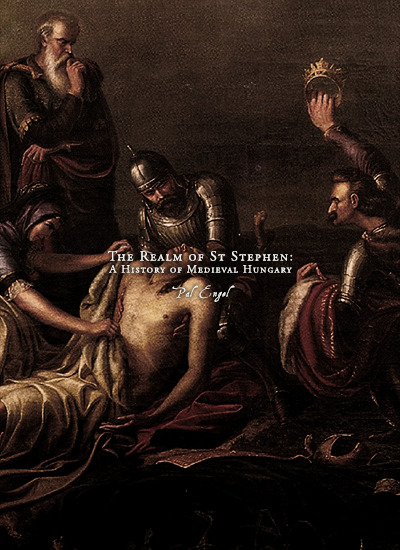
Favorite History Books || The Realm of St Stephen: A History of Medieval Hungary by Pál Engel ★★★★☆
This book was written for the non-Hungarian reader who wishes to discover what happened in the Carpathian basin during the Middle Ages. It is to be hoped that nobody living in that region who has strong national feelings will find comfort in it. Each of the nations of the region has its own vision of the past, incompatible with that of the others, and it was my firm intention that none of these visions should be represented in this volume. ...
Hungary is now one of the smallest countries of Europe. This book, however, is concerned with the medieval period, and here the name ‘Hungary’ will refer to the former kingdom of Hungary, which (even without the kingdom of Croatia which was once united with it) was more than three times larger than the present-day republic, and also somewhat larger than the combined area of Great Britain and Ireland. It extended over the whole of the Carpathian basin, including not only present-day Slovakia, but also considerable parts of Romania, Ukraine, Austria, Yugoslavia and Croatia. Although the kingdom of Hungary ceased to exist as an independent country at the end of the Middle Ages, politically it survived as an autonomous part of the Habsburg Empire until the end of the First World War in 1918.
The medieval kingdom of Hungary was born in a geographically well-defined region that is usually called the Carpathian basin. This is the drainage-area of the middle Danube valley, and is named after those mountain ranges with 2000 metre peaks that border it to the north, the east and the south. It is divided by the Danube into two parts of unequal proportions, and its centre is surrounded by mountain ranges of medium height. The region to the west of the Danube has been called Transdanubia since the period of the Ottoman occupation when the capital of the country was temporarily moved from Buda to Pressburg, on the northern bank of the river. The climate here is predominantly temperate, with a relatively heavy rainfall. This is a fertile landscape with hills of modest elevation interrupted by valleys and basins, and with the Balaton, the largest warm-water lake in Europe, at its heart. There are also mountain ranges – the Mecsek in the south-east, the Bakony and the Vértes north of the Balaton – but none rises higher than 600 metres. The landscape east of the Danube is profoundly different. The Great Hungarian Plain, which stretches without a single hill from Budapest to Oradea in the east and Belgrade in the south, can be regarded as a kind of appendix to the Eurasian steppe. The climate is rather more extreme here, with hot, dry summers, but the region is abundantly supplied with water by its main river, the Tisza, and its tributaries, which, before the nineteenth-century regulation works, meandered across the Great Plain. These rivers were flanked by marshlands, swamps and inundation forests, and also by fertile pastures and meadows, offering favourable conditions for fishing and livestock breeding. To the north, east and south-east of the Great Plain, in present-day Slovakia and Romania, there are mountain ranges that become progressively higher as one travels outwards from the Plain. They were formerly extremely rich in minerals; but, with the exception of the valleys, they have never been propitious to human settlement. Consequently, until the late Middle Ages these mountains were covered by forests and largely uninhabited, and colonization of them continued into the early modern period.
#historyedit#house of arpad#hungarian history#capetian house of anjou#medieval#european history#history#history books#nanshe's graphics
23 notes
·
View notes
Text

Vetrenjača (windmill)
Section
Čurug, Vojvodina
This drawing records a windmill that remained in operation in Čurug into the 1970s, and was relocated to its present site in 1912. The conical walls are of unfired brick, and wall thickness reduced with each successive floor. The internal parts, including the wings, were brought from Hungary in 1846, on the Tisza River. These internal parts are of wood, the shaft, gears, and transfer mechanism. The four wings are of fir, formed as ladders. Depending on the wind force, the mill could operate one, two, or three stones. (drawing by author 2015 from base drawings by preservation institute)
8 notes
·
View notes
Text

Hardly was the stone-bridge finished, it inspired songs. It is so well placed that the Hortobágy cannot be imagined without it. Its constructor, Ferenc Pavolny based his name in Hungarian bridge-building with this creation. The bridge finished in 1833 is the longest and the most beautiful stone-bridge of Hungary. Its full length is 167.3 meters, the body of the bridge is 92.13 meters long. The stones were brought from Tokaj to Tiszacsege on the Tisza and from there it was transported by wagons to the location. The 400,000 bricks necessary to the bridge were burnt by wood brought from the Oak-wood of Ohat.
The most important road between Transylvania and Pest-Buda, that had been an important commercial road from the Middle Ages, crossed the river Hortobágy here. The development of Debrecen increased the importance of this road in salt-transportation and cattle-trading. A wooden bridge had always been here before, where toll was also taken. Documents refer to it from 14th century. The totally renovated bridge in 1702 was made of wood. The council of Debrecen decided to build a stone-bridge in 1827, which was finished six years after.
Before the river regulation many wooden bridge crossed the Hortobágy and its side-waters. The Zádor-bridge near Karcag was built in a style similar to the nine-arch bridge before the regulation of the Tisza, but the flooding washed away two of its pillars. Today this area is waterless, and the bridge is standing on a dry land.
3 notes
·
View notes
Text
So, last spring and summer Hungary had pretty horribly bad drought, and this spring and summer we are likely to have bad drought again, and it’s not going to be fun, food prices-wise.
It’s not at all comforting, but on some level it is interesting to know that it’s not all the fault of global warming, global warming is just compounding a 100-year-old problem. Back in the 19th century, Hungary was much… waterier. Large portions of the Great Hungarian Plain were flooded on a yearly basis, and even larger portions of it were flooded randomly, in bad years. So in the 19th century, Hungary began a huge project to regulate our major waterways: the Danube, the Tisza, even the three Körös rivers.
The upsides were significant. Huge amounts of arable land were made safe from flooding, helping to feed tens of thousands of people. Entire villages and towns were protected from unpredictable and catastrophic flood damage. Water-borne and mosquito-borne diseases became much less frequent. Large-scale trade and travel by ship became far more viable for far more people. But there were serious downsides.
The massive old swamps dried up and disappeared, as did their beautiful biodiversity, as did the average poor farmer’s access to fish, crabs and wild bird eggs, so basically protein. And the other downside was the drought, like seriously unexpected levels of drought. Some areas produced more food when they were made safe from flooding, but other areas just stopped working once they were cut off from the river. Bye bye arable land, hello weird tufts of sad grass. Sure, there are some naturally-occurring desert-like environments in Hungary, and they are fine, they are their own beautiful little biome, but that’s not what I’m talking about here, I’m talking about the dead cracked salinized plains that weren’t there a hundred and fifty years ago.
6 notes
·
View notes
Text
Top 10 biggest cities in Hungary
Hungary, a landlocked country in Central Europe, is known for its rich history, stunning architecture, and vibrant culture. Its cities blend old-world charm with modern amenities, offering visitors a diverse range of experiences.
Here are the top 10 biggest cities in Hungary, each with its own unique attractions and character:
Budapest: As the capital and largest city of Hungary, Budapest is a vibrant metropolis renowned for its grand architecture, thermal baths, and cultural attractions. Highlights include the majestic Buda Castle, the iconic Chain Bridge, and the historic thermal baths of Széchenyi and Gellért. Visitors can also explore the bustling streets of the Jewish Quarter and enjoy panoramic views of the city from Gellért Hill.
Also Read: Luxembourg visa from Kerala
Debrecen: Located in eastern Hungary, Debrecen is the country's second-largest city and a cultural hub known for its universities, festivals, and historical landmarks. Visitors can explore the Great Reformed Church, stroll through the bustling Kossuth Square, and relax in the tranquil surroundings of Nagyerdő Park. Debrecen also hosts the annual Flower Carnival, a vibrant celebration of floral artistry.
Szeged: Situated on the banks of the Tisza River in southern Hungary, Szeged is a charming city famous for its beautiful architecture, lively cultural scene, and spicy cuisine. Highlights include the Szeged Cathedral, the Dóm Square, and the stunning Art Nouveau buildings along the riverfront. Visitors can also sample the city's renowned fish soup and attend performances at the Open-Air Theatre Festival.
Also Read: Croatia visa
Miskolc: Located in the northeast of Hungary, Miskolc is the country's fourth-largest city and a gateway to the Bükk Mountains. Visitors can explore the historic downtown area, visit the medieval Diósgyőr Castle, and relax in the thermal baths of Miskolc-Tapolca. The nearby cave baths of Lillafüred and the picturesque Szinva Terrace are also popular attractions.
Pécs: Nestled in the foothills of the Mecsek Mountains in southwestern Hungary, Pécs is a city rich in history, culture, and architectural heritage. Highlights include the Pécs Cathedral, the Early Christian Necropolis, and the atmospheric streets of the Old Town. Visitors can also explore the Zsolnay Cultural Quarter, home to a renowned ceramics museum and art galleries.
Also Read: Czech republic visa
Győr: Situated in western Hungary, Győr is a historic city known for its well-preserved Baroque architecture, charming Old Town, and vibrant cultural scene. Highlights include the Győr Cathedral, the Bishop's Castle, and the picturesque riverside promenade. Visitors can also enjoy performances at the Rába Quelle Thermal Spa and the annual Győr Summer Festival.
Nyíregyháza: Located in the northeast of Hungary, Nyíregyháza is a dynamic city known for its cultural attractions, green spaces, and family-friendly activities. Highlights include the Sóstó Zoo, one of the largest in Central Europe, the Nyíregyháza Open-Air Museum, and the tranquil shores of Lake Nyíregyháza. Visitors can also explore the city's vibrant markets and sample local delicacies.
Also Read: Netherlands visa from India
Kecskemét: Situated in the heart of the Great Hungarian Plain, Kecskemét is a charming city known for its Art Nouveau architecture, vibrant cultural scene, and traditional Hungarian cuisine. Highlights include the Kecskemét Town Hall, the Cifra Palace, and the Hungarian Museum of Photography. Visitors can also explore the city's bustling squares, parks, and artisan workshops.
Székesfehérvár: Located in central Hungary, Székesfehérvár is one of the country's oldest and most historic cities, with a rich heritage dating back to the Roman era. Highlights include the Bory Castle, the medieval ruins of the Székesfehérvár Cathedral, and the charming streets of the Old Town. Visitors can also explore the city's museums, galleries, and cultural institutions.
Also Read: Iceland visa from India
Veszprém: Nestled in the hills of western Hungary, Veszprém is a picturesque city known for its historic architecture, cultural festivals, and scenic surroundings. Highlights include the Veszprém Castle, the Hungarian Museum of Agriculture, and the charming Castle Hill district. Visitors can also explore the city's parks, gardens, and hiking trails in the nearby Bakony Mountains.
Hungary Visa
Traveling to Hungary from India or Kerala requires obtaining a visa, depending on the purpose and duration of your visit. Here's what you need to know about Hungary visa requirements:
Hungary Visa from India: Indian citizens planning to visit Hungary for tourism, business, or other purposes are required to obtain a Schengen visa. The Schengen visa from India allows holders to travel freely within the Schengen Area, which includes Hungary and other European countries. To apply for a Hungary visa from India, applicants must submit their visa application through the Hungarian consulate or embassy in India. The application process typically requires providing documents such as a valid passport, visa application form, passport-sized photos, travel itinerary, proof of accommodation, and sufficient financial means. Applicants may also need to attend a visa interview and provide biometric data as part of the application process.
Hungary Visa from Kerala: Similarly, residents of Kerala planning to visit Hungary must apply for a Schengen visa through the Hungarian consulate or embassy in India. The visa application process for residents of Kerala is the same as for Indian citizens from other states. Applicants must submit the required documents and complete the visa application form, paying the necessary fees. It's essential to apply for the visa well in advance of your planned travel dates to allow sufficient time for processing and approval.
In conclusion, Hungary offers a wealth of cultural, historical, and natural attractions to explore in its largest cities. Whether you're interested in exploring medieval castles, soaking in thermal baths, or experiencing vibrant cultural festivals, Hungary has something to offer for every traveler. However, it's essential to check visa requirements and plan your trip accordingly to ensure a smooth and hassle-free travel experience.
Also Read: Lithuania visa from Kerala
0 notes
Text

Wondering why travel to Szeged? This Hungarian gem offers a blend of history, culture, and culinary delights that will leave any traveler spellbound. Situated on the banks of the Tisza River, Szeged boasts stunning architecture, including the iconic Votive Church and the grandiose Széchenyi Square. But it’s not just about the sights – Szeged is a culinary paradise, renowned for its spicy fish soup and mouthwatering paprika-infused dishes. Whether you’re exploring its historic streets, relaxing in its vibrant cafes, or soaking in the thermal baths, Szeged promises an unforgettable experience that will captivate your senses and leave you longing to return.
Consider a journey to Hungary, a gem awaiting exploration. Travel to Hungary promises a blend of rich history, stunning architecture, and captivating landscapes. Enjoy your travel to Europe.
#traveling#travel#travel tips#travel destinations#travel the world#travelew#europe#places to visit#visit europe#szeged#hungary
0 notes
Text
CarolCooks2…A-Z World Cuisines…Part 35…Hungary...
Welcome to part 35 of my virtual world tour of cuisines…Today I am taking you on a virtual tour of Hungary a landlocked country in Central Europe…
No sea but Hungary’s two longest rivers… The Danube and Tisza divide Hungary into three parts: Transdanubia (to the west of the Danube), the plain between the Rivers Danube and Tisza, and the Trans-Tisza region (to the east of the Tisza). Hungary’s…

View On WordPress
0 notes
Text

War was all she had known. Born, raised, lived in one that simply seemed eternal. Instead of learning etiquette worthy of her rank, Countess, Rozália fenced, made bows and arrows, rode horses at alarming speed. She was educated regarding warfare and politics, no room for pretty flowers or embroidery. Her upringing laid in her roots: Véghváry; meaning 'from the border fortress'. Her family history stretched back to King Matthias' rule, many great, loyal, talented fighters, tacticians, leaders, advisors were born from this blood and served brilliantly to such levels it caught the eye of the King and the bloodline was granted noble ranks along with southern territories of Hungary.
With the Ottoman expansion, land had shrunk, the fighting spirit strengthened. Women also learned how to defend themselves and even the fort if it came to it. Despite being aristocracy, arranged marriages weren't practiced, even same sex couples tolerated. They were waging a war, how could've they prohibited who to love in this short life? Even if it was the handsome warrior or the daughter of the maid instead of a noble lady. They faced and conquered fear every day, with every breath, one should find safety instead of dread in family, no matter who they fell in love with. Regarding finances, it all went to repairs, salaries, ammunition, to the poorer families and serfs. They dressed as soldiers instead of aristocrats, only a few items they considered luxury to have.
Rozália was born in 1531 to an Italian aristocrat mother Lorella and Count Attila Véghváry, five years after the catastrophic Battle of Mohács. The damage was immeasurable and a permanent turning point of the country; the chain of southern forts protecting the border had fallen. The remaining had to relocate to northern strongholds to avoid a complete wipeout after two centuries of holding the opposing force back. Countess Rozália Bianka Véghváry grew up in a crumbling, tearing country with both parents determined to teach her all skills necessary to survive, perhaps even follow her father's footsteps as Lorella couldn't bear more children.
She was a fast, eager learner, wanting to reach the heights of the heroic tales she was told, to truly earn the weight of the looks she was regarded with. The heir. The only one and all eyes were watching. War was in her veins, to such prominence that she was the one to warn Attila they should prepare for a raid more effectively or relocate again entirely. She was only a child and scared, of course her concerns were brushed off, Attila knew better. Or so he thought until his daughter's prophecy manifested on a moonless night. Chaos, senseless bloodshed, women, children screaming until they couldn't anymore. Suffering heavy losses, Attila could barely escape with his daughter whom he had dragged away from an Ottoman corpse; her first kill. His wife laid lifeless among the debris, torture evident.
Nobody knew what the ten year old Rozália saw happen with her mom. The relationship with her father was fundamentally changed, she never forgave him for Lorella's death. For putting his pride first, for not listening to her. She grew bitter, resentful, only acknowledging him as if he was her superior instead of father. They relocated to Tiszagyöngye (Pearl of Tisza), a fort near Eger, right next to the unpredictable Tisza river. Rozália trained harder, pushed her limits till she almost collapsed from exhaustion, spent the remaining time sharpening her intellect, fully preparing to replace her father now when the occupants eventually reach Tiszagyöngye. She knew it was only a matter of time.
She was right, again. After the unsuccessful siege of Eger, they came for Tiszagyöngye in 1553. Although the damage was almost minimal at that time, a deep infected laceration claimed Attila Véghváry's life, making Rozália the captain of the fort at the age of 22. No longer a child, perhaps she was never one, the already battle hardened young woman took the title with almost voracious thirst, eager to be rid of her incompetent father and the spineless German mercenaries paid by him. So her reign began. Brilliant strategist, master of many weapons, excellent rider, fearless, courageous, inspiring, commanding and cunning. Her merciless slaughter of Turk raiders raised attention, yet no matter who or how many was sent in her way, they all were cut down with precision. Selim Pasha requested a duel on a nearby hill upon hearing the seemingly overexaggerated prowess of one woman. A woman! When he was greeted in his language with a twirl of twin sabers was when he started to realize what he had heard was not colored but rather watered down. They fought for hours tirelessly in the afternoon sun, so long that her soldiers decided to check. Upon the unexpected reinforcement Rozália declared the duel over, showing even though they were enemies, she fought with honor as well. Selim Pasha in that moment knew she had to die. Too much talent, ambition, bloodthirst, knowledge and fairness in one person; he respected her enough to acknowledge the danger the young Fort Captain embodied.
A brutal siege with overwhelming numbers followed the next year. Rozália knew it was lost the second she assessed the powers laid out, lost unless... She gave up Tiszagyöngye. Left the fatally wounded and the most valiant within the ruined walls. From a distance she watched the Ottoman army pour into her fortress and after a few minutes explode as the remaining ignited all gunpowder within the walls, flammable debris purposely left around the only entrance creating a hellish death trap. She watched flames reach sky high, cries of agony rising with it till it was silence and white smoke from the ruins. The rebuild started immediately, all of her remaining inheritance funding it with some assistance from neighboring fortresses and lesser nobility. The reconstruction was complete by 1558, the fortress christened to Főnixvár (Phoenixfort) after with the dragon protecting it.
Location:
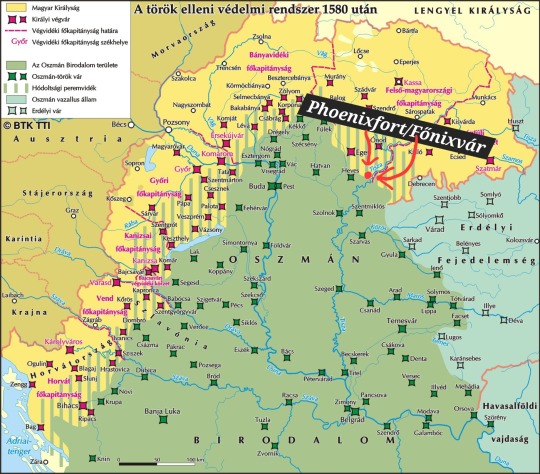

Layout and bastion names:
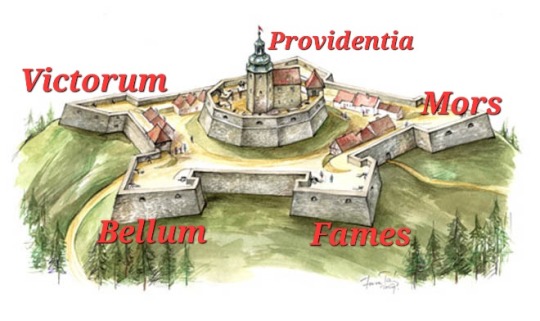
Victorum (Conquest) points towards Eger
Bellum (War) bears the most of the damage, facing straight at the occupied territory, her usual resting/lookout place
Fames (Famine) and Mors (Death) are the closest to the Tisza river prone to floods
Providentia (Providence) points towards the remaining Kingdom of Hungary
Nowadays Countess Fort Captain Rozália Véghváry when not fighting an endless war is often seen among common people, encouraging, listening, helping with matters considered trivial to her rank and status. She often patrols the border or simply taking a small break from the monumental duties placed on her, riding a blood bay coated horse, Vihar, whose fur seems to burn infernal red in the sunlight.
Timeline:
Base interactions take place after 1561 when she's past 30
Born: 1531
Buda fell in 1541 (age 10)
Ottoman raid resulting in the death of her mother & forced to retreat to Tiszagyöngye: 1545 (age 14)
1545-1553: honing, perfecting her skills and learning new ones, preparing for her fate
First Siege of Tiszagyöngye, death of her father, becoming Fort Captain: 1553 (age 22)
Duel with Selim Pasha: 1554 (age 23)
Second Siege of Tiszagyöngye, ending with her burning the fort down with the army trapped inside: 1555 (age 24)
Rebuild of Főnixvár complete in 1558 (age 27)
Verse headcanon post

#🇭🇺 16th century verse🩸| resistance; liquid fire in my veins: my soul the burning sun against the crescent moon#back on my history bullshit even more but I wanted to show the true glory of this name#Good god the pull to make it into a sideblog was STRONG but thankfully I couldn't think of an url. (yet.)
1 note
·
View note
